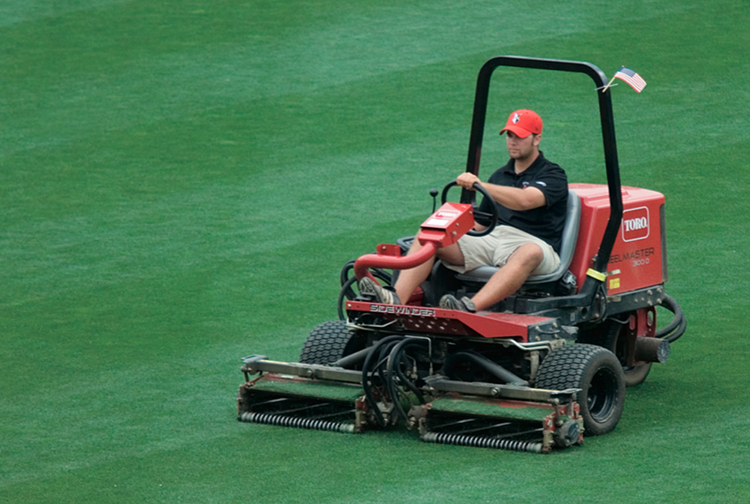Home > New Jersey > New Jersey Crops & Livestock > Turfgrass Greens Up New Jersey Economy
Turfgrass Greens Up New Jersey Economy
 Million-dollar athletes play on the New Jersey-grown sod with high expectations for solid footing. Likewise, South Jersey turf blankets the National Mall in Washington, D.C., where millions annually take in the capital’s famous swath of green.
Million-dollar athletes play on the New Jersey-grown sod with high expectations for solid footing. Likewise, South Jersey turf blankets the National Mall in Washington, D.C., where millions annually take in the capital’s famous swath of green.
“It is neat to say certain players are playing on our turf or that our turf is at a certain stadium or place,” says Allen Carter, manager of Tuckahoe Turf Farms, a family sod farm in South Jersey.
From the Midwest to the Northeast, Tuckahoe Turf Farms installs its Jersey-grown sod in major sports venues and prominent locations, including the U.S. capital. The farm provides the home turf for the Boston Red Sox, Pittsburgh Pirates and other Major League Baseball teams. Its turfgrass graces National Football League stadiums for the Philadelphia Eagles, Pittsburgh Steelers and Chicago Bears. The New York Red Bulls and Philadelphia Union professional soccer teams perform on their Jersey-grown turf, too.
Major sports teams demand quality footing and root development, desire certain shades of green and seek data on recovery time for damaged grass. In fact, Tuckahoe Turf Farms hosted a soccer tournament on its farm during one Easter weekend not only to market the turfgrass, but also to stress it, Carter says. The following week, representatives from seven NFL teams visited the farm to analyze the turf’s recovery and select the green patch of land for their upcoming season.
Home Turf
The turf industry contributed $3.2 billion to the New Jersey economy and provided 53,588 jobs in 2001, according to the most up-to-date study for the New Jersey Turfgrass Industry Economic Survey from Rutgers University. Bruce Clarke, director of the Center for Turfgrass Science at Rutgers, estimates the industry delivers the same or greater economic impact today, after its resurgence following the economic downturn. “Most people in the state really don’t recognize that turfgrass is of economic importance,” he says.
Within the turfgrass industry, New Jersey is home to nearly 30 farms that produce sod on almost 9,000 acres as of 2001. Tuckahoe Turf Farms grows 700 acres of sod, owned and operated by the third generation of the Betts family. Grandfather Walter Betts started sod production on the farm in 1967.
![Turf [INFOGRAPHIC]](https://eadn-wc01-4177395.nxedge.io/wp-content/uploads/2020/05/Screen-Shot-2016-08-29-at-4.52.21-PM.jpg) The farm today grows two types of cool-season grasses: tall fescue for residential use and Kentucky bluegrass primarily for athletic fields, Carter says. The farm’s management team continually makes adjustments to seed varieties, seeding rates and fertilizer to develop a premier turf from South Jersey soils.
The farm today grows two types of cool-season grasses: tall fescue for residential use and Kentucky bluegrass primarily for athletic fields, Carter says. The farm’s management team continually makes adjustments to seed varieties, seeding rates and fertilizer to develop a premier turf from South Jersey soils.
“Our goal is to stay ahead of the curve – keep a nice dark green grass without disease and thatch buildup,” Carter says.
The farm employs 42 people during its harvest season, which runs from March to December.
Long Turf History
For nearly a century, the New Jersey turfgrass industry has progressed with the support of Rutgers University, home to the largest turfgrass breeding program in the world. Rutgers developed more than half of the cool-season grasses sold in the U.S. today, Clarke says.
“Rutgers prides itself in trying to develop turfgrasses with improved drought, heat and overall stress tolerance,” he says. “And you’re looking at grasses that utilize fewer pesticides, less fertilizer and also grasses that perform really well under traffic, whether foot or mechanical.”
Rutgers implements outreach efforts that promote best management practices to maintain healthy turfgrass. Quality turf delivers a host of benefits, such as soil stabilization, cooler ambient temperatures, enhanced groundwater recharge, cleaner air and a healthy playing surface for recreational activities.
“There is much more to turf than visual aesthetics,” Clarke says.



